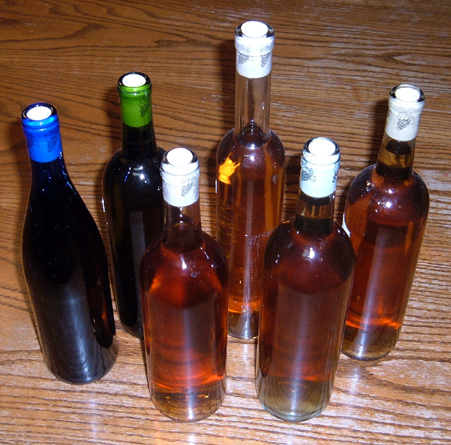
I'm happy that the mead came out very clear. I'm puzzled by the rich amber color, though. The must had started out a beautiful dark rose color, due to the deep maroon prickly pear fruit I used. Oddly, the color lightened as it aged, which I didn't expect. I'd intended to oak the must, but never got around to it. I tried to get a good acid balance, since I'd used a lot of honey here and the potential for sweetness was strong. I also added some tannins to give it more complexity, but I have to admit I chose to err on the light side, since heavy tannin content is a turn off for me in wine and I wasn't sure how my experimentation would turn out.
Once the dozen or so bottles were safely corked, I opened up one half-bottle from the earlier bottling six weeks earlier that I'd placed in the fridge to chill. Mead can be horribly wretched to drink when it hasn't aged, and describing the taste as harsh and medicinal wouldn't be inaccurate. So I prepared for the worst--the only reason I was opening this one is because the oxygen in the bottle left it unsuitable for long-term storage. I was pleasantly surprised. Yes, it's still got that rough edge I expected, but that bite was muted. There was not much residual sweetness at all. This wine wasn't dry, but it wasn't sugary. Semi-dry is the official term, I suppose, but the sweetness was almost neutral. The acid balance was almost perfect, and although I couldn't actually taste any of the tannins I'd added, I could tell there was more depth to the flavor than in the previous meads I'd attempted. This makes me happy. It reminded me more than anything else of a decent, not-too-sweet riesling (although the alcohol content is much higher). One big surprise was the aftertaste--I couldn't taste any of the fruit initially, but a light, refreshing flavor lingered quite a while after swallowing. It was fruity, but hard-to-place and almost delicate, which makes sense since prickly pear fruit isn't a flavor that immediately comes to mind, even to someone like me who's had it before. A year from now, this has the potential to be some Very Good Stuff indeed.
I still have a gallon of mint and a gallon of jalapeno mead aging in glass carboys. I've racked them a couple of times, but neither has cleared to my satisfaction, so I'll be employing clarifying agents soon. But those two were just experiments--the prickly pear mead was my big project, and it appears (knock wood) to be a success.
Now Playing: Ray Charles Ultimate Hits Collection

They're really beautiful. I bet they taste just as good!
ReplyDeleteThanks for the kind words! They do taste better than, say, Mad Dog 20/20, but I wouldn't go so far to say they're good yet. I've quickly learned that mead, even moreso than wine, needs extended aging to develop good flavor. Or rather, to lost nasty flavor. Anyone who's sampled mead younger than 6 months of age can easily describe the harsh, medicinal taste. You really wonder if something went wrong in the fermentation process and ruined the whole batch. After 6 months this begins to fade, and after a year mead starts maturing into some Pretty Good Stuff. :-)
ReplyDelete